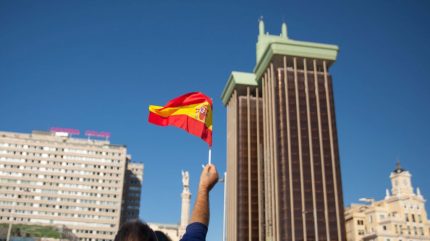
Spain’s ten largest cities are Madrid, Barcelona, Valencia, Seville, Zaragoza, Malaga, Murcia, Palma, Las Palmas and Bilbao. Here we profile each of them and look at the sectors in which they excel.
Read through GlobalData’s exclusive insights on the Population of Spain (2017 – 2025,People).
1. Madrid
Population: 3.14 million (metropolitan population: 6.16 million)
Madrid is Spain’s capital city and its economic and political centre. It is a major European financial centre, although the services sector tends to dominate its economy. Madrid became a 20th-century manufacturing powerhouse for goods as diverse as automobiles, chemicals, pharmaceuticals, food and leather goods. In the 21st century, this has given way to more technical niches, backed by 17 universities and more than 30 research centres. Madrid is also an important hub in Spain when it comes to infrastructure and construction, and as befitting a large capital city with a sunny climate, tourism is a major contributor to its economy, with many travellers coming to watch Real Madrid play football at the Santiago Bernabéu Stadium. Companies headquartered in Madrid include Bankia, Iberia Airlines, Logista, Telefónica and Mahou-San Miguel Group.
2. Barcelona
Population: 1.6 million (metropolitan population: 5.18 million)
Based in the region of Catalonia, Barcelona’s status as a globally renowned centre for tourism and football remains undiminished. However, the city is also a hub for finance and biotech, with a strong start-up scene. Manufacturing is also important to Barcelona’s economy, with the energy, chemical and metallurgy industries the most prominent. It is also important to the automotive industry, and hosts the headquarters of Seat. Fashion and textiles are also areas in which Barcelona thrives. The Catalonian capital is also one of the most important cultural hubs in Europe and includes eight Unesco World Heritage sites.
3. Valencia
Population: 790,000 (metropolitan population: 1.65 million)
Valencia is located on Spain’s east coast. It hosts the busiest port in the whole Mediterranean region, and the fifth busiest in Europe. In 2018, its annual container volume was 5.2 million TEUs. Away from the port, Valencia’s economy is driven by tourism and construction, although telecommunications and transport are also prominent in the city. The services sector is a major employer in Valencia.
4. Seville
Population: 690,000 (metropolitan population: 1.31 million)
Seville is located in southern Spain, about 340km from the border with Portugal. It is a hugely popular destination for tourists, and hosts three Unesco World Heritage sites. Seville has undergone huge infrastructure improvements over the past 30 years, and has also emerged as a research and development hub in Spain. It is also renowned for its role in the renewable energy industry.
5. Zaragoza
Population: 660,000 (metropolitan population: 686,000)
Zaragoza is located in north-east Spain, just over 100km from the French border. The transport and automotive sectors are key to Zaragoza’s economy, with Opel operating a plant near the city, CAF building railway rolling stock there, and it being home to the Spanish air force. Zaragoza Airport also acts as a major cargo hub. The city hosted Expo 2008, where sustainable development was a key theme.
6. Malaga
Population: 570,000 (metropolitan population: 1.22 million)
Malaga, located on Spain’s southern coast, has acquired a reputation for being a high-end tourism destination. However, the city also has strengths in construction and technology services, transportation and logistics. It is considered a tech hub in Spain, is home to the headquarters of Spanish bank Unicaja, and is also rife with manufacturing activity.
7. Murcia
Population: 440,000 (metropolitan population: 623,000)
Murcia is found on the south-east coast of Spain and is, like most coastal Spanish cities, reliant on tourism. However, the city is also a major hub for agriculture in Spain, in relation to both crops and fisheries. Beyond these fields, Murcia has a very active services sector, while it is also highly regarded in Spain for the quality of its museums and theatres.
8. Palma (Majorca)
Population: 400,000 (metropolitan population: 593,000)
Palma is the largest city on the Balearic island of Majorca. Its economy is highly reliant on tourism, with up to 80% of the city’s population working in jobs reliant upon the industry. Beyond tourism, Palma is an important location for agriculture, growing and exporting almonds, oranges, lemons and olives. It also has deposits of copper, lead and marble.
9. Las Palmas (Gran Canaria)
Population: 380,000 (metropolitan population: 640,000)
Las Palmas is the largest city in the Canary Islands, sitting on the north coast of Gran Canaria. It is located about 150km from the north-east coast of Africa. As with Palma, tourism is by some distance the most important industry to the city’s economy, although its seaport is a busy import/export hub. Fishing is also a key industry in Las Palmas.
10. Bilbao
Population: 350,000 (metropolitan population: 990,000)
Bilbao is the largest city in Spain’s Basque Country. It is located on the country’s northern coast, less than 100km from the French border. The city has in recent years won numerous awards and accolades for its liveability, and its cultural offering is renowned throughout Europe. As a result, tourism contributes hugely to Bilbao’s GDP, but a busy port, a strong financial offering (Bilbao is home to the multinational BBVA bank), and mining and ironworks industries mean that it has a very diverse economy.
City populations figures based on Statista numbers from 2015. Metropolitan figures are from ESPON, 2007.



